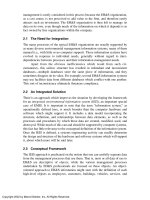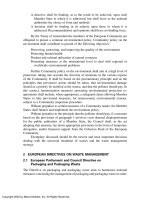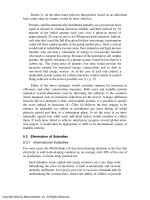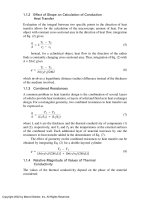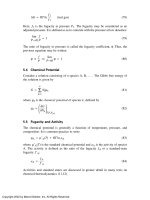Springer network control and engineering for QOS security and mobility III (2005) DDU lotb
Bạn đang xem bản rút gọn của tài liệu. Xem và tải ngay bản đầy đủ của tài liệu tại đây (10.88 MB, 363 trang )
NETWORK CONTROL AND ENGINEERING FOR
QOS, SECURITY AND MOBILITY, III
IFIP – The International Federation for Information Processing
IFIP was founded in 1960 under the auspices of UNESCO, following the First World
Computer Congress held in Paris the previous year. An umbrella organization for societies
working in information processing, IFIP’s aim is two-fold: to support information processing
within its member countries and to encourage technology transfer to developing nations. As
its mission statement clearly states,
IFIP’s mission is to be the leading, truly international, apolitical organization
which encourages and assists in the development, exploitation and application
of information technology for the benefit of all people.
IFIP is a non-profitmaking organization, run almost solely by 2500 volunteers. It operates
through a number of technical committees, which organize events and publications. IFIP’s
events range from an international congress to local seminars, but the most important are:
The IFIP World Computer Congress, held every second year;
Open conferences;
Working conferences.
The flagship event is the IFIP World Computer Congress, at which both invited and
contributed papers are presented. Contributed papers are rigorously refereed and the rejection
rate is high.
As with the Congress, participation in the open conferences is open to all and papers may be
invited or submitted. Again, submitted papers are stringently refereed.
The working conferences are structured differently. They are usually run by a working group
and attendance is small and by invitation only. Their purpose is to create an atmosphere
conducive to innovation and development. Refereeing is less rigorous and papers are
subjected to extensive group discussion.
Publications arising from IFIP events vary. The papers presented at the IFIP World Computer
Congress and at open conferences are published as conference proceedings, while the results
of the working conferences are often published as collections of selected and edited papers.
Any national society whose primary activity is in information may apply to become a full
member of IFIP, although full membership is restricted to one society per country. Full
members are entitled to vote at the annual General Assembly, National societies preferring a
less committed involvement may apply for associate or corresponding membership. Associate
members enjoy the same benefits as full members, but without voting rights. Corresponding
members are not represented in IFIP bodies. Affiliated membership is open to non-national
societies, and individual and honorary membership schemes are also offered.
NETWORK
CONTROL AND
ENGINEERING FOR
QOS, SECURITY
AND MOBILITY, IIl
IFIP TC6 / WG6.2, 6.6, 6.7 and 6.8 Third International Conference
on Network Control and Engineering for QoS, Security and
Mobility, NetCon 2004 on November 2-5, 2004, Palma de
Mallorca, Spain.
Edited by
Dominique Gaïti
Université Technique de Troyes,
France.
Sebastià Galmés
Universitat de les Illes Balears,
Spain.
Ramon Puigjaner
Universitat de les Illes Balears,
Spain.
Springer
eBook ISBN:
Print ISBN:
0-387-23198-6
0-387-23197-8
©2005 Springer Science + Business Media, Inc.
Print ©2005 by International Federation for Information Processing.
Boston
All rights reserved
No part of this eBook may be reproduced or transmitted in any form or by any means, electronic,
mechanical, recording, or otherwise, without written consent from the Publisher
Created in the United States of America
Visit Springer's eBookstore at:
and the Springer Global Website Online at:
Contents
Preface
ix
Committees
xi
Reviewers
PART ONE: Network Policy
1
2
3
Configuration Model for Network Management
R. Deca, O. Cherkaoui and D. Puche
On-line Control of Service Level Agreements
M. C. Penna and R. R. Wandresen
1
3
15
Revenue-aware Resource Allocation in the Future Multi-service
IP Networks
J. Zhang, T. Hämäläinen and J. Joutsensalo
27
PART TWO: Network Security
4
xiii
41
A Kerberos-based Authentication Architecture for Wireless
LANs: Test beds and Experiments
M. A. Kaafar, L. Ben Azzouz and F. Kamoun
43
vi
Network Control and Engineering for QoS, Security and Mobility, III
5
An Efficient Mechanism to Ensure Location Privacy in Telecom
Service Applications
57
O. Jorns, S. Bessler and R. Pailer
6
Network Security Management: A Formal Evaluation Tool based
on RBAC Policies
69
R. Laborde, B. Nasser, F. Grasset, F. Barrère and A. Benzekri
PART THREE: Quality of Service
81
7
A Dynamic Cross Layer Control Strategy for Resource
Partitioning in a Rain Faded Satellite Channel with Long-Lived
TCP Connections
83
N. Celandroni, F. Davoli, E. Ferro and A. Gotta
8
Content Location and Distribution in Converged Overlay
Networks
97
O. Unger and I. Cidon
9
A Communication Architecture for Real-Time Auctions
H. Kaffel Ben Ayed, S. Kaabi Chihi and F. Kamoun
PART FOUR: Wireless Networks
111
125
10 An Interference-Based Prevention Mechanism against WEP
Attack for 802.11 b Network
127
W.-C. Hsieh, Y.-H. Chiu and C.-C. Lo
11
Restricted Dynamic Programming for Broadcast Scheduling
S. Wang and H.-L. Chen
139
12 Performance Comparison of Distributed Frequency Assignment
Algorithms for Wireless Sensor Networks
151
S. Waharte and R. Boutaba
13 Fast Handoff Support in an IP-evolved UMTS Architecture
L. Dimopoulou, G. Leoleis and I. S. Venieris
163
PART FIVE: Intelligent Networks
177
14 Storage Capacity Allocation Algorithms for Hierarchical Content
Distribution
179
N. Laoutaris, V. Zissimopoulos and I. Stavrakakis
Network Control and Engineering for QoS, Security and
Mobility, III
vii
15 An Inference Algorithm for Probabilistic Fault Management in
Distributed Systems
J. Ding, B. Krämer, Y. Bai and H. Chen
193
16 New Protocol for Grouping Data Using Active Network
A. Moreno, B. Curto and V. Moreno
205
PART SIX: Performance Evaluation
219
17 An Algebraic Model of an Adaptive Extension of DiffServ for
MANETs
O. Salem and A. Benzekri
221
18 Cross-layer Performance Evaluation of IP-based Applications
Running over the Air Interface
D. Moltchanov, Y. Koucheryavy and J. Harju
235
19 Collision Avoidance Issues in Metropolitan Optical Access
Networks
N. Bouabdallah, A.-L. Beylot and G. Pujolle
249
PART SEVEN: Posters
263
20 Toward an Intelligent Bandwidth Broker Model for Resources
Management in DiffServ Networks
R. Nassrallah, M. Lemercier and D. Gaïti
265
21
A Learning and Intentional Local Policy Decision Point for
Dynamic QoS Provisioning
F. Krief and D. Bouthinon
277
22 Generic IP Signaling Service Protocol
T. T. Luu and N. Boukhatem
289
23 On Distributed System Supervision - A Modern Approach:
GeneSys
J.-E. Bohdanowicz, L. Kovacs, B. Pataki, A. Sadovykh and S.
Wesner
303
24 Multigroup Communication Using Active Networks Technology
315
A. Chodorek and R. R. Chodorek
viii
Network Control and Engineering for QoS, Security and Mobility, III
25 Policy Usage in GMPLS Optical Networks
B. Daheb and G. Pujolle
327
26 Beyond TCP/IP: a Context-Aware Architecture
G. Pujolle, H. Chaouchi and D. Gaïti
337
Index of Contributors
347
Preface
This volume contains the proceedings of the Third International
Conference on Network Control and Engineering for Quality of Service,
Security and Mobility (Net-Con’2004), celebrated in Palma de Mallorca
(Illes Balears, Spain) during November 2-5, 2004. This IFIP TC6
Conference was organized by the Universitat de les Illes Balears and
sponsored by the following Working Groups: WG6.2 (Network and
Internetwork Architectures), WG6.6 (Management of Networks and
Distributed Systems), WG6.7 (Smart Networks) and WG6.8 (Mobile and
Wireless Communications).
The rapid evolution of the networking industry introduces new exciting
challenges that need to be explored by the research community. The
adoption of Internet as the global network infrastructure places the issue of
quality of service among one of the hot topics nowadays: a huge diversity of
applications with quite different service requirements must be supported
over a basic core of protocols. Also, the open and uncontrolled nature of
Internet enforces the need to guarantee secure transactions among users, thus
placing security as another hot topic. Finally, the explosion of mobility and
its integration as part of the global infrastructure are probably now the most
challenging issues in the networking field.
According to these trends, the intention of the conference was to provide
a forum for the exchange of ideas and findings in a wide range of areas
related to network control and network engineering with a focus on quality
of service, security and mobility control. The main program covered three
days and included six sequential sessions and a poster session. Also, the
x
Network Control and Engineering for QoS, Security and Mobility, III
program was enriched by a keynote speech and two invited talks offered by
prestigious and world-renowned researchers in the networking field: Guy
Pujolle from the University of Paris 6 (France), who imparted the keynote
speech, Harry Perros from the North Carolina State University (USA) and
Özgur B. Akan, from the Georgia Institute of Technology (USA). The main
conference program was complemented by a variety of stimulating and highquality tutorials.
Dominique GaÏti
Sebastià Galmés
Ramon Puigjaner
Committees
GENERAL CHAIR
R. Puigjaner (Universitat Illes Balears, Spain)
PROGRAM CO-CHAIRS
D. Gaïti (University of Troyes, FR)
S. Galmés (Universitat Illes Balears, ES)
STEERING COMMITTEE
A. Casaca (INESC, PT)
A.A. Lazar (Columbia University, US)
Al-Naamany (Sultan Qaboos University, OM)
O. Martikainen (Micsom, SF)
G. Pujolle (LIP6, FR)
J. Slavik (Testcom, CZ)
O. Spaniol (RWT Aachen, DE)
TUTORIAL CHAIR
J.-L. Ferrer (Universitat Illes Balears, ES)
FINANCIAL CHAIR
B. Serra (Universitat Illes Balears, ES)
xii
Network Control and Engineering for QoS, Security and Mobility, III
PROGRAM COMMITTEE
A. Al-Naamany (Sultan Qabous University, OM)
F. Arve Aagesen (Norwegian University, NO)
G. Bianchi (Universita di Palermo, IT)
A. Benzekri (Université Paul Sabatier, FR)
C. Blondia (Univestiy of Antwerpen, BE)
R. Boutaba (University of Waterloo, CA)
A. Casaca (INESC, PT)
O. Cherkaoui (UQAM, CA)
W. Dabbous (INRIA, FR)
F. Davoli (Univesita di Genova, IT)
J. Domingo (Universitat Politècnica Catalunya, ES)
O. Duarte (Universidade Federal de Rio de Janeiro, BR)
A. El Sherbini (National Telecommunication Inst. EG)
J. Escobar (Centauritech, PA)
L. Fratta (Politecnico de Milano, IT)
G. Haring (Wien Univeristät, AT)
D-Y. Hu (Inst. of Network Technology, CN)
L. Huguet (Universitat Illes Balears, ES)
V. B. Iversen (Technical University of Denmark, DK)
F. Kamoun (Université La Manouba, TU)
U. Korner (Lund University, SE)
G. Leduc (Université de Liège, BE)
G. Omidyar (Institute for Communications Research, SG)
G. Pacifici (IBM - US)
H. Perros (North Carolina State University, US)
G. Pujolle (LIP6, FR)
F.J. Quiles (Universidad de Castilla La Mancha, ES)
T. Saito (Toyota, JP)
B. Serra (Universitat Illes Balears, ES)
J. Slavik (Testcom, CZ)
O. Spaniol (RWT Aachen, DE)
Y. Stavrakakis (Universtiy of Athens, GR
Y. Takahashi (Kyoto University, JP))
F. Tobagi (Stanford University, US)
ORGANISING COMMITTEE
L. Carrasco (Universitat Illes Balears, ES)
I. Furió (Universitat Illes Balears, ES)
M. Payeras (Universitat Illes Balears, ES)
Reviewers
A. Al-Naamany
F. A. Aagessen
G. Bianchi
V. Benetis
A. Benzekri
A. Bermúdez
R. Boutaba
S. Calomme
B. Caminero
A. Casaca
O. Cherkaoui
P. Cuenca
F. Davoli
R. Deca
O. Duarte
A. El Sherbini
J.-M. François
L. Fratta
M. Ghaderi
D. Gaïti
S. Galmés
M. Gambardella
A. Garrido
S. Hallé
G. Haring
B. Helvik
L. Huguet
V. B. Iversen
J. Janecek
F. Kamoun
K-T Ko
O. Kure
N. Laoutaris
G. Leduc
F. Lo Piccolo
C. Matteo
G. Omidyar
A. Panagakis
H. Perros
R. Puigjaner
G. Pujolle
F. J. Quiles
R. Reda
F. Ricciato
N. Rico
B. Serra
M. Sichitiu
B. Simak
F. Skivée
J. Slavik
O. Spaniol
Y. Stavrakakis
Reviewers
xiv
Y. Takahashi
D. Tianshu Li
L. Truong
L. Tzevelekas
A. Vaios
S. Waharte
J. Xiao
Y. Xin
L. Xu
Part One: Network Policy
This page intentionally left blank
CONFIGURATION MODEL FOR NETWORK
MANAGEMENT
Rudy Deca1, Omar Cherkaoui 2 and Daniel Puche3
1,2
University of Quebec at Montreal; 3Cisco Systems, Inc.
Abstract:
As today’s networks increase in size and complexity and new network services
are deployed, the management becomes more complex and error-prone and the
configurations can become inconsistent. To enforce the configuration
consistence and integrity, it is necessary to enhance the validation capabilities
of the management tools. The Meta-CLI Model presented in this paper
captures the dependences among the configuration components and the
network service properties and translates them into validation rules. It also
translates the device configuration information into tree-like models and
checks their integrity and consistence using theses rules.
Key words:
network management; network services; integrity and consistence validation;
configuration rules; configuration constraints; configuration model.
1.
INTRODUCTION
The constant growth of the Internet implies the creation and deployment
of an ever increasing number of network services, each of which is
becoming more complex in its turn. In this context, the network
configuration becomes more difficult and error prone. Some of the causes
are the diversity of configuration approaches and information repositories
used by the configuration tools.
In plus, the main network configuration approaches, such as the
command line interfaces (CLIs),1,2 the Simple Network Management
Protocol (SNMP),3 the policy-based management (PBM), 4 the NetConf
protocol,5 etc., lack configuration rules that capture the dependences and
constraints that characterise the network service configuration and lack
adequate logical formalisms that could be applied to the information
repositories to validate the configuration integrity and consistence.
4
Rudy Deca, Omar Cherkaoui and Daniel Puche
These approaches therefore do not take into account the dependences and
hierarchy that exist among the device parameters that express the service at
device-level, the heterogeneity of the configuration means and the
interactions between heterogeneous management and configuration modes.
The Meta-CLI Model proposes a solution for these configuration
inconsistencies. Our model captures the features of the CLI, such as the
context and parameter dependences of the commands, as well as the service
properties into validation rules. It translates the configuration information
into trees and validates them using the appropriate rules. Based on the MetaCLI Model, we have implemented the ValidMaker module, and incorporated
it in a policy provisioning VPN tool.
This section presents the dependences between the commands and/or
parameters that are translated into Meta-CLI concepts and discusses the
properties of the network service configurations. Section 2 presents the
concepts, operations, functions and properties of the Meta-CLI Model tree
structures and the validation rules and procedures that translate and validate
the service properties. Section 3 presents the ValidMaker tool and Section 4
draws conclusions.
1.1
Configuration Dependences
Several types of dependences exist in the network device configurations.
A. Syntactic parameter constraints The CLI commands’ syntax enforces
the constraints regarding the order and number of parameters.
1. Fixed number of parameters The number of parameters (which can be
mandatory or optional) must be correct, otherwise the command fails.
EXAMPLE The command to configure a primary IP address on an interface
requires 2 parameters: the interface IP address and the mask.
2. Fixed sequential order of parameters. In a configuration command or
statement, the parameters are ordered.
EXAMPLE In an extended access list, the order of the IP address and the
mask parameters in the above-mentioned command is fixed.
B. Parameter and command existence dependences Some parameters and
commands can only exist in specific circumstances.
1. The existence of a parameter depends on another
EXAMPLE In an access list, the timeout parameter, which specifies the
duration of a temporary access list entry, can exist only if the access list
entry is dynamic (i.e. has the dynamic parameter).
2. Context dependences The existence of a parameter or a command
depends on the context (mode). Thus, a parameter can only be
configured, modified or created in an equipment using a command in a
specific configuration context (mode).
Configuration Model for Network Management
5
EXAMPLE When specifying the IP address of an interface, the name of the
interface must be specified by a prior command that “opens” it to the user,
who can then access and manipulate its resources or parameters (e.g.: IP
address, MTU, bandwidth, etc.).
3. Result dependence The order of some commands can be fixed. In this
case, the success of a command depends on the successful completion of a
previous one.
EXAMPLE The configuration of a link bundle consists of bundling several
similar physical point-to-point links between 2 routers into 1 logical link. By
default, at each change in bandwidth in a link bundle, the combined amount
of bandwidth used on all active member links is propagated. Optional
features are available, by configuring the following parameters.
I. Automatic propagation, which sends the bandwidth changes to
upper layer protocols for the bandwidth threshold.
II. Bandwidth threshold, which sets the value of the threshold. If the
actual bandwidth is smaller or equal, it is propagated, otherwise
the nominal bandwidth is transmitted.
If we invert the configuration order of these 2 parameters, the threshold will
not be set, since it requires the existence automatic propagation.
C. Value dependences among parameters
1. Parameters of the same command are dependent
EXAMPLE When specifying a classful IP address, the net mask must be
consistent with the first two bits of the IP address. For instance, the B class
IP address starts with the bits 10 and has the mask 255.255.0.0.
2. Parameters of different commands on the same device are dependent.
EXAMPLE An access list is identified by its number parameter, which is
referenced when the access list is attached to an interface. If we change this
ID number in one place, we should change it likewise in the other, lest the
functionality is lost. Parameters that reference each other may have the same
or different names.
3. Parameters on different devices are dependent
EXAMPLE The connectivity between 2 devices requires the IP addresses of 2
interfaces directly connected to be on the same subnet.
D. Parameter Hierarchy and Service Composition In a configuration, there
is a hierarchy of elements from simple to complex, namely from the
parameters, going through several levels of aggregation, up to the
network services. This grouping expresses the common goal and of the
components and the dependences that exist among them.
1. Grouping parameters under commands. At the bottom, several
parameters can be configured simultaneously using commands or
statements, which group them based on logical links.
6
Rudy Deca, Omar Cherkaoui and Daniel Puche
EXAMPLE An access list entry command specifies several packet parameters
to be matched, such as: source and destination addresses, direction of the
packet, protocol, port, whether it is dynamic or not, timeout, etc. Various
dependences among some of these parameters have already been highlighted
in the examples in the previous paragraphs § A and § B.1.
2. Grouping commands under services. The commands can be grouped as
well, if they serve a common goal, i.e. a feature or a service. For instance,
an access list is composed one or more access list entries, which are
bound by the common access list number.
3. Network service composition. A network service can rely on simpler
network services, according to a recursive, hierarchical model.
EXAMPLE. A Virtual Private Network (VPN) service requires: a network
tunneling, e.g. through LSPs provided by an MPLS protocol, BGP
connectivity (e.g. by means of neighbors), for the provider’s backbone
network, and IGP connectivity between the customer sites and the backbone,
e.g. by means of RIP or OSPF protocols.
In complex services, such as BGP MPLS-based VPNs, VLANs, etc.,
there are multiple dependences at different hierarchical levels.
1.2
Dependences among network service components
Due to their complexity, the dependences can exist at different levels
within network services, from parameters to sub-services.
1. Parameter and command dependences As already shown, the parameters
and commands that compose the services can have their intrinsic, lowerlevel, dependences, which can be either independent or dependent on the
device environment (software and hardware).
EXAMPLE The dependence C.1 is generic, whereas D.2 is command
implementation-specific.
2. Sub-service dependences. At the top of the service hierarchical structure,
there are higher-level dependences among the component sub-services.
These dependences are dependent on the service- and network-level
information, e.g. network topology, technology, protocols, etc., rather
than on the devices, and span multiple equipments.
EXAMPLE If several customer sites use overlapping address spaces and are
connected to more than one VPN, the corresponding PEs must ensure traffic
isolation among the various VPNs by enforcing specific constraints on their
forwarding tables.6
These properties are high-level and generic, and need to be transposed
into concrete, lower-level properties, by adapting to concrete network and
equipment environments, in order to be applicable to the configuration.
Configuration Model for Network Management
7
For instance, a VPN service can be materialized by a provider tunneling
technology such as the Multi-protocol Label Switching (MPLS). The MPLS
may run on an IP network and use the multi-protocol Border Gateway
Protocol (MP-BGP) for VPN routing advertising among the edge routers and
the MP-BGP may use the direct neighbors for configuration on the edge
routers. We will explain these concepts and features in the following
example.
1.2.1
MPLS VPN Service Example
A VPN is a private network constructed within the network of the service
provider, which ensures the connectivity and privacy of customer’s
communications traffic.7 For this purpose, the sites (which are contiguous
parts of networks) of the customer network are connected to the provider’s
network through direct links between the interfaces of the devices that are at
the edges of these networks, i.e. the Customer Edge device (CE) and the
Provider Edge device (PE), as shown in Figure 1 (site 3 has been omitted
from this representation, to save space).
The VPN service in the example is configured on the PE routers using
the IOS1 commands, without loss of solution’s generality and validity since,
as mentioned before, the generic service properties must be transposed into
concrete properties by mapping the configuration components to specific
CLIs, such as IOS, JUNOS,2 etc. The provider specifies VPN routing
information (by means of the VPN Routing and Forwarding tables – the
VRFs) on the PE routers’ interfaces that are connected to the corresponding
CE routers of the customer’s sites. (There are many implementations of the
VPN service. Our example uses the BGP MPLS-based VPN.) Figure 2(a)
presents some highlights from the configuration file of the PE-1 router,
which are explained in the following paragraphs. (A configuration file
contains lists of commands, grouped by contexts, which customize the
parameters of various configuration components, e.g. interfaces, protocols,
security, etc. of network equipments, such as routers and switches.)
Commands 1-4 create and define the VRF Blue. This VRF is then
assigned by command 8 to the appropriate interface that connects the PE
router to the customer’s network. The PE router must be directly connected
to the CE router of the customer site and learn local VPN routes. Command
5 configures the interface to be used for this router’s connectivity inside the
provider network and command 6 assigns it an IP address.
Command 10 illustrates the configuration of the OSPF process in the
VRF Blue and command 11 specifies the network directly connected to the
router (and containing the interface IP address configured by command 9).
Command 12 ensures that the OSPF process advertises the VPN routing
8
Rudy Deca, Omar Cherkaoui and Daniel Puche
information learned from across the provider’s network by means of the
BGP protocol, into the CE router.
Figure 1. VPN example. Customer sites 1 and 2 are linked through CE routers to PE routers,
which communicate over the service provider’s network
The PE router exchanges customer and provider VPN routing
information with other PE routers from the provider’s network using the
MP-BGP. Command 13 configures MP-BGP routing process by specifying
the local autonomous system and commands 14-19 add the routing
information necessary for the connection to other PE routers across the
provider’s network, i.e. autonomous system, interface type, number and IP
address used by the remote PEs. Notice that we use the simplest method to
configure the BGP process between PEs, namely the direct neighbor
configuration.
The BGP needs also its own address family, vpnv4, which allows it to
carry VPN-IPv4 in order to uniquely identify the addresses of different
customers (commands 23, 25) and to advertise the extended community
attribute (commands 24, 26).
1.2.2
VPN Configuration Properties
In this example, we can describe many properties, but we will restrict
ourselves here to only two properties that the configuration must have with
respect to the neighbor command and its relationships with other commands
(from the same PE router and from other PE routers).
PROPERTY 1 The address of the interface of a PE router that is used by
the BGP process for PE connectivity must be defined as BGP process
neighbor in all of the other PE routers of the provider.
EXAMPLE In Figure 2(a), a neighbor with the address 194.22.10.2 is
configured by commands 14-16. This corresponds to the IP address of the
Loopback0 interface of router PE-2. Conversely, the PE-1 router’s
Loopback0 IP address, i.e. 194.22.10.1, must be defined as a neighbor of the
BGP processes of the other PE routers (PE-2, PE-3, etc.).
Configuration Model for Network Management
9
Figure 2. Selected commands that configure a VPN service in the configuration file of the
provider edge router PE-1 (a), and the corresponding MCM tree PE-1a that models them (b).
PROPERTY 2 The address family vpnv4 must activate and configure all of
the BGP neighbors for carrying only VPN IPv4 prefixes and advertising the
extended community attribute.
EXAMPLE In Figure 2(a), the commands 23, 24 activate and advertise the
extended community attribute of the neighbor 194.22.10.2, configured by
the commands 14-16 under the BGP process. We have here an instance of a
command whose various parameters are configured in two different
contexts.
10
2.
Rudy Deca, Omar Cherkaoui and Daniel Puche
THE META-CLI MODEL
The Meta-CLI Model8–10 abstracts the configuration information of the
devices and network services into tree-like structures and the network
services configuration dependences and constraints into rules which it uses
to configure network services and to validate their consistence and integrity.
2.1
The MCM Trees and Nodes
The Meta-CLI Model develops the hierarchical architecture of the
configuration properties and information into the MCM tree concept.
DEFINITION 1 The MCM tree is a tree that has its name in the root and the
configuration contexts, the command names, and the command parameters
of a device configuration in its nodes.
EXAMPLE In Figure 2(b), the router (command 13) is a command mode
and the address-family (commands 20, 22) is its sub-mode. The commands,
e.g. ip address (command 6), are appended as children or descendants (node
10) of the command modes, e.g. interface (command 5, node 7) and submodes to which they belong.
DEFINITION 2 An MCM tree node is a vertex of an MCM tree and
represents a CLI configuration mode, command name or parameter.
The MCM tree node contains intrinsic information, such as the data,
consisting of a type (e.g. “subnet mask”) and a value sub-attributes (e.g.
255.255.255.255), a default
value,
possible values of the
commands/parameters, node operations, etc. and structural information. The
latter deals with the links and relationships between nodes, such as: child
nodes and the path, which consists of the data of the ancestor nodes starting
from the root.
DEFINITION 3 A node type represents a class or category of configuration
modes, commands or parameters. The type of a node N is denoted by N.type.
DEFINITION 4 A node value represents the value of the command or
parameter modeled by the node. The value of a node N is denoted by
N.value. The type of a MCM tree node is unchangeable whereas the value
may be changed.
DEFINITION 5 The node data represent the type and value of the node.
The data of a node N are denoted by N.data.
EXAMPLE The type, value and data of node 41 in Figure 2(b) are: N.type
= neighbor, N.value = 194.22.10.2 and N.data = neighbor:194.22.10.2,
respectively.




